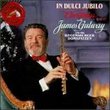| All Artists: Johann Sebastian Bach, Andrew Parrott Title: Heart's Solace Members Wishing: 0 Total Copies: 0 Label: Sony Release Date: 4/14/1998 Genre: Classical Styles: Opera & Classical Vocal, Historical Periods, Baroque (c.1600-1750), Symphonies Number of Discs: 1 SwapaCD Credits: 1 UPC: 074646015520 |
Search - Johann Sebastian Bach, Andrew Parrott :: Heart's Solace
 | Johann Sebastian Bach, Andrew Parrott Heart's Solace Genre: Classical
Andrew Parrott's first disc for Sony isn't the most cheerful debut imaginable--two funeral motets and a cantata mourning the death of a Saxon princess. But it's all Bach, so the music, however solemn, is sublime. Parrott e... more » |
Larger Image |
CD DetailsSynopsis
Amazon.com Andrew Parrott's first disc for Sony isn't the most cheerful debut imaginable--two funeral motets and a cantata mourning the death of a Saxon princess. But it's all Bach, so the music, however solemn, is sublime. Parrott experiments with the one-singer-per-part approach he's used for most of his Bach recordings: one motet and the cantata's opening chorus are sung by soloists; the other motet and the cantata's chorales get two singers per part. The singing and playing in the Trauer-Ode cantata are marvelous, probably the best available; the motets are beautifully done as well, but there's little to choose between this performance and the equally good one by Cantus Cölln (also performed one-singer-per-part). In any case, this disc is certainly worth having--especially for the Trauer-Ode. --Matthew Westphal Similarly Requested CDs
|
CD ReviewsNot just a pretty album cover R. Gerard | Pennsylvania USA | 03/07/2003 (5 out of 5 stars) "This record is an abolute must for those even remotely interested in Bach's works. Andrew Parrott has released many records using the One Voice Per Part theory, put forth by Joshua Rifkin. This one, by far has to be one of the better ones of his Bach releases.The thick reverberation is thanks to the performance venue. This release was recorded in St. Jude's in Hampstead Gardens, London. The massive church sound is quite possibly a more accurate representation of what one might have heard in the Leipzig churches that Bach was responsible for music-wise. For me, the reverberation compliments the religious air of Bach's vocal works- especially the motets, two of which are recorded here, accompanying the Funeral-Ode, BWV 198.With this record (which has a theme of death and the afterlife) Parrot prooves that such a small ensemble (which Bach would have likely used) can succesfully narrate the deepest human emotions just as well as, if not better than, a larger choir.The voices are all excellent. They sparingly use vibrato, faithful to baroque performance practice. In the motet, "Komm, Jesu, Komm," we also have the opportunity to hear Panito Iconomou, no longer a boy-alto from the Tolzer Knabenchor, but a mature-sounding and burly bass. Adult female altos and sopranos are used, but their boyish sounding voices make this recording more believable and uniform.The orchestra is polished and balances well with the voices. Many people realize that the One Voice Per Part approach balances much better with an orchestra. Thanks to the minimal forces, each voice, each line, and therefore more of Bach's intentions, are meticulously heard.This is clearly a must-have recording."
|

 Track Listings (23) - Disc #1
Track Listings (23) - Disc #1







![Across The Universe [Deluxe Edition]](https://nationalbookswap.com/cd//m/51/1251/1241251.jpg)
